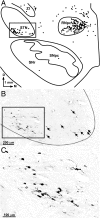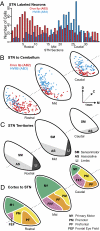The basal ganglia communicate with the cerebellum
- PMID: 20404184
- PMCID: PMC2889518
- DOI: 10.1073/pnas.1000496107
The basal ganglia communicate with the cerebellum
Abstract
The basal ganglia and cerebellum are major subcortical structures that influence not only movement, but putatively also cognition and affect. Both structures receive input from and send output to the cerebral cortex. Thus, the basal ganglia and cerebellum form multisynaptic loops with the cerebral cortex. Basal ganglia and cerebellar loops have been assumed to be anatomically separate and to perform distinct functional operations. We investigated whether there is any direct route for basal ganglia output to influence cerebellar function that is independent of the cerebral cortex. We injected rabies virus (RV) into selected regions of the cerebellar cortex in cebus monkeys and used retrograde transneuronal transport of the virus to determine the origin of multisynaptic inputs to the injection sites. We found that the subthalamic nucleus of the basal ganglia has a substantial disynaptic projection to the cerebellar cortex. This pathway provides a means for both normal and abnormal signals from the basal ganglia to influence cerebellar function. We previously showed that the dentate nucleus of the cerebellum has a disynaptic projection to an input stage of basal ganglia processing, the striatum. Taken together these results provide the anatomical substrate for substantial two-way communication between the basal ganglia and cerebellum. Thus, the two subcortical structures may be linked together to form an integrated functional network.
Conflict of interest statement
The authors declare no conflict of interest.
Figures




References
-
- Alexander GE, DeLong MR, Strick PL. Parallel organization of functionally segregated circuits linking basal ganglia and cortex. Annu Rev Neurosci. 1986;9:357–381. - PubMed
-
- Strick PL, Dum RP, Fiez JA. Cerebellum and nonmotor function. Annu Rev Neurosci. 2009;32:413–434. - PubMed
-
- Percheron G, François C, Talbi B, Yelnik J, Fénelon G. The primate motor thalamus. Brain Res Brain Res Rev. 1996;22:93–181. - PubMed
-
- Hoshi E, Tremblay L, Féger J, Carras PL, Strick PL. The cerebellum communicates with the basal ganglia. Nat Neurosci. 2005;8:1491–1493. - PubMed
-
- Kelly RM, Strick PL. Rabies as a transneuronal tracer of circuits in the central nervous system. J Neurosci Methods. 2000;103:63–71. - PubMed
Publication types
MeSH terms
Grants and funding
LinkOut - more resources
Full Text Sources
Other Literature Sources

